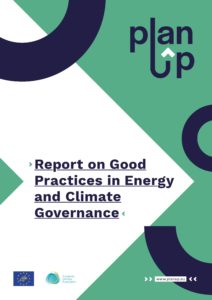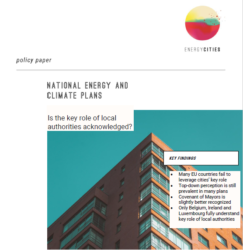9 country lessons + 10 recommendations = 1 effective National Energy and Climate Plan
New LIFE PlanUp report provides guidance on participative governance to national policymakers
With EU Member States set to submit their final national energy and climate plans (NECPs) by the end of the year to the EU Commission, they need to tap into the potential of their cities and citizens to design and deliver robust, ambitious and mutually beneficial plans. A new report from the LIFE PlanUp project provides national policymakers with a blueprint on how to involve cities, civil society and the public in their NECPs through multilevel climate and energy dialogues.
The LIFE PlanUp report presents good practice examples in the form of case studies from seven EU Member States – the France, Netherlands, Sweden, Luxembourg, Ireland, Germany and Estonia – as well as from outside Europe, by focusing on Canada and the US State of California. In these examples, a multilevel climate and energy dialogue compliant with the EU regulation governing the NECPs (i.e. Article 11 of the Energy Union and Climate Action Governance Regulation) has been successfully developed and implemented in various ways. Furthermore, these examples met the LIFE PlanUp criteria for an energy and climate governance framework to be a good practice.
The nine good practices featured in the report are listed below:
- France: National Debate for 2015 Law on the Energy Transition for Green Growth
- Netherlands: Stakeholder roundtables for national climate agreement
- Sweden: Parliamentary committee with stakeholders for Long-Term Climate Policy Framework 2017
- Luxembourg: Climate Pact between State and municipalities
- Ireland: The National Dialogue on Climate Action
- Germany: National Dialogue for 2050 Climate Action Plan
- Estonia: Stakeholder working groups for 2050 General Principles of Climate Policy
- Canada: Pan-Canadian Framework on Clean Growth and Climate Change
- California: Stakeholder inclusion in Global Warming Solutions Act
The good practices in energy and climate governance highlight a wealth of options for national policymakers to involve local actors in the form of a multilevel climate and energy dialogue in their NECPs. Stakeholder/citizen commissions, regional gatherings, climate councils, sectoral working groups or dialogue fora are just some of the proven and replicable formats that have been already successfully used at national level.
A win-win partnership for the local and national level
The report further shows that the inclusion of local actors in a multilevel climate and energy dialogue brings multiple benefits for both the local and national level in the NECPs. By tapping into the experience, know-how and engagement of cities, civil society and the public, national policymakers can leverage key contributions to the planning process, trigger further investments, share responsibilities more equitably, raise the plan’s overall ambition and ensure its more adequate and swift implementation. Moreover, such an approach also increases public support and ownership, mobilizes all actors, strengthens coordination and cooperation between local and national policymakers and thereby bridges the gap between the local and national level in the NECP process. In Luxembourg for example, especially the views from municipalities were taken up in the development and implementation of the country’s Climate Pact. As a result, the Climate Pact succeeded in mobilizing all 105 Luxembourgish municipalities for effective climate action.
10 recommendations to EU governments on involving local actors in the NECPs
Drawing from the good practices in energy and climate governance analyzed, the LIFE PlanUp report lays out 10 recommendations for national policymakers in EU countries on how to develop and implement a multilevel climate and energy dialogue in their NECPs, providing in particular guidance on involving cities, civil society and the public:
- Involve key political institutions in design of governance framework to gather strong political backing;
- Entrust local and regional authorities with a key role in a governance framework to achieve national goals, by:
- Supporting their efforts with critical technical and financial assistance;
- Removing any barriers preventing their effective action (e.g. on investments, regulation, administrative rules)
- Leaving them with the flexibility to design and implement suitable climate and energy measures
- The leading institution in a governance framework should provide other entities with key functions in the process;
- Set up a governance structure that is equipped with the necessary means and a clear mandate;
- Engage and involve stakeholders and citizens through formats that enable co-creation, promote real debates and strike a balance of representation between all interests;
- Enable stakeholders and citizens to co-shape the process to develop and implement a governance framework;
- Make a governance framework actionable through sufficient resources, clear actions to undertake and a clear division of responsibilities;
- Make documentation and information available in an early and effective manner;
- Include procedures for strategic revision in a governance framework and build capacity to adjust to changes and challenges;
- Ensure effectiveness through ambitious and coherent targets, detailed and feasible policies and a clear and robust monitoring and evaluation process to track progress;



